Journal
of Non-lethal Combatives, Aug 2000
The Secrets of Jujitsu, A Complete Course in Self
Defense, Book II
By Captain Allan Corstorphin Smith, U.S.A.
Winner of the Black Belt, Japan, 1916. Instructor of Hand-to-Hand Fighting,
THE INFANTRY SCHOOL, Camp Benning, Columbus, Georgia and at United States
Training Camps and Cantonments, 1917 and 1918.
In Seven Books.
BOOK TWO.
STAHARA PUBLISHING COMPANY
Columbus, Georgia, 1920.

***
This electronic version is copyright EJMAS © 2000. All rights
reserved.
Contributed by Thomas J. Militello, a 15-year member of Astoria,
New York's non-profit Horangi Taekwondo Dojang, which is headed by James
Robison.
Readers interested in seeing film images should note the following
film held by the National Archives and Record Administration:
NWDNM(m)-111-H-1180.
Title: Physical and Bayonet Training, 1918.
Scope and Content: Recruits at Camp Gordon, Georgia receive detailed
instruction in boxing and jiu-jitsu. Wrestling and jiu-jitsu holds are
used against a foe with a bayonet. Troops do calisthenics and play rough
games calculated to make them physically fit.
35mm film, 15 minutes
FORM A SELF-DEFENSE CLUB
It does not matter what sort of a partner you first practice with. Keep
a record of your progress by making a check mark against a trick each day
you practice it. The first day a trick may take five or ten minutes, and
after that only one or two minutes.
Let your opponent try all the tricks on you, you will learn a great
deal from this.
Get at least one friend enthused to the point where he will procure
a set of textbooks for his private study and will keep a record of his
progress.
After four such practices with one opponent, you should try to practice
each trick with as many different opponents as you can get.
Each man has a different style of physique and you have not mastered
the course till you can do the tricks effectively on any style of opponent.
Popularize this practice amongst your circle of friends to provide yourself
with opponents. Some one of your friends may develop a better style of
doing a certain trick than you, and it will be to your advantage to practice
it with him.
All this practice must be formal and not competitive. Once you start
wrestling in a haphazard way you will hinder the orderly study of the course.
To attack one another with "any old trick" will result in severe falls,
and should only be done on a mat after you have learned how to fall. This
will be taught in the second course.
It is quite unnecessary to so in this course which is a complete and
adequate system of self-defense and can be learnt without such strenuous
practice.
LESSON 6
This lesson teaches you --
How to clasp hands when taking hold.
An interesting variation of the waisthold.
The chin shove.
Correct leverage in the chin shove.
Advanced practice in the chin shove.
| |
Name of Partner |
Date Practice Commenced |
Waisthold |
Chin Shove |
| 1. |
|
|
|
|
| 2. |
|
|
|
|
| 3. |
|
|
|
|
| 4. |
|
|
|
|
| 5. |
|
|
|
|
| 6. |
|
|
|
|
| 7. |
|
|
|
|
| 8. |
|
|
|
|
| 9. |
|
|
|
|
| 10. |
|
|
|
|
Make a check mark against each trick each day you practice it.
In clasping hands behind opponent's back always take the grip shown
in fig. 23.
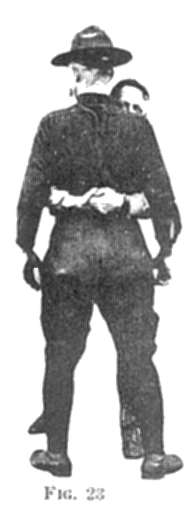
Unless he is a much smaller man, in which case clasp your left wrist
with your right hand.
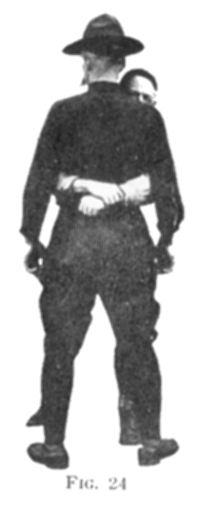
Never use the grip shown in fig. 25.
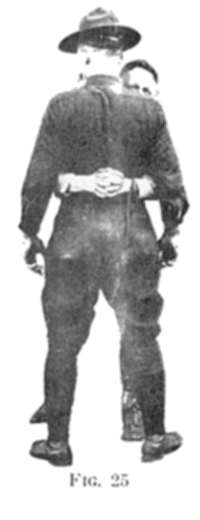
If your opponent falls on your fingers when they are clasped this way
they may be broken.
Again, if he lies beneath you his weight may jam your fingers so that
you would have difficulty in freeing your arms while his arms would be
free to attack.
These instructions as to correct methods of clasping hands are chiefly
for the man who acts in the role of Assailant in this waisthold series,
and in the "Seized from Behind Series" in Book 4.
AN INTERESTING VARIATION OF THE WAISTHOLD
There is a peculiarly sensitive spot about two inches long up and
down each side of the backbone halfway between the waistline and shoulders.
Press the big third knuckle joint of your first finger into your first
finger into your own back till you discover the spot.
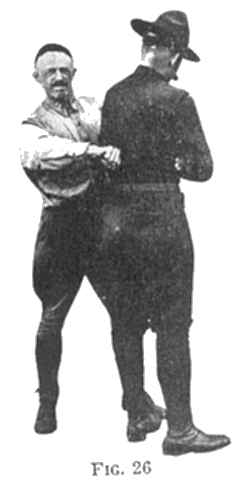
Apply pressure here with the knuckle simultaneously with the pressure
of your chin on his chest and the pain will cause him to quit.
As soon as he quits, let go and allow him to practice on you.
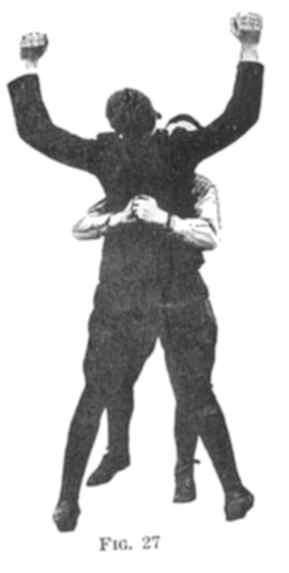
Some men are not sensitive to pressure here, but many people are so
susceptible to pain at this spot that the trick will cause them to quit,
and may even knock them out. Therefore when applying it to anyone, go slowly
at first.
Experiment on each other a few times that you may acquire a moderation
and temperance and so avoid injuring a less robust companion.
NOTES ON THE WAISTHOLD
Before practicing the chin shove given on the following page you and
your partner should execute the waisthold as taught in Book 1, three times
each.
The waisthold is not much use against a heavier man and is not taught
in this course for its fighting value.
It is taught in order to provide an Assailant for the man who wants
to learn the chin shove. It is the first link in the chain of dovetailed
tricks.
It is taught because by means of it you learn the correct method of
practice before proceeding to the more advanced tricks which might be dangerous
unless practiced properly.
It takes away the beginner's nervousness before he comes to the more
advanced tricks.
CHIN SHOVE
"ONE"
Assailant steps forward with left foot as if trying to secure the waisthold.
Step forward and slip your left hand inside Assailant's right arm and
place it halfway around his waist.
Place the palm of your right hand under Assailant's chin, forearm straight
up and down and close to his chin.

"TWO"
Pull his waist forward with your left hand. Shove his head backward
with your right until he is in position of fig. 29.
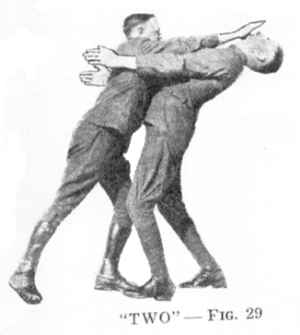
Be careful not to let him fall. Keep your balance in the Stahara.
This movement is not done by sheer strength, but by destroying Assailant's
balance through the proper coordination of your right and left hands.
Be careful not to jerk his head back. In a real fight you would
do so, but if you hurt your partner it will simply curtail your practice.
WRONG WAY TO TRY CHIN SHOVE
If you hold your elbow away out as shown in fig. 30 you are using only
your arm and shoulder muscles against the strength of his neck.
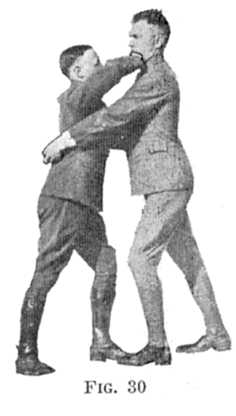
This is using your strength to the least advantage, as an ordinary man's
neck is stronger than his arm and shoulder.
Take the right position of fig. 28, and put the strength of your Stahara
-- the strength of your whole body -- into the trick.
Experiment and learn the correct method of shoving.
In a real fight you will not stop at the position shown in fig. 29,
but will throw opponent over backward.
If performed with sufficient quickness he will be knocked out by the
concussion of his head on the ground.
Further, there would be no pause between "ONE" and "TWO" which is simply
the analytical method of learning this trick.
It is unnecessary to throw the opponent in practice.
CORRECT LEVERAGE IN CHIN SHOVE
Take position of fig. 31. Assailant is holding you around waist. You
have your hand on his chin.
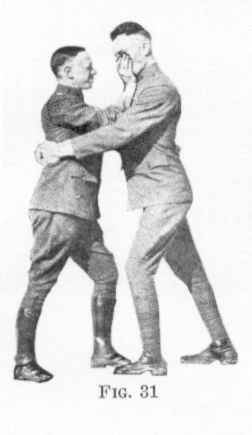
Let him stiffen his neck and resist your efforts to push him back, so
that you are struggling with him strength against strength. You will be
unable to push him back.
Instead of continuing to push back against his strength push up,
dropping your body a little so that your Stahara is behind the upward effort.
This will instantly get him off balance and you can easily subdue
him.
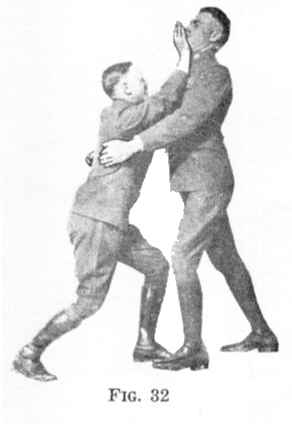
ADVANCED PRACTICE IN THE CHIN SHOVE
Compare your position with each illustration until you have learnt the
applied mechanics of the trick and can get a stronger man off his balance
and so discount his strength by scientific shoving.
This method enables you to commence your study of this course with the
same safety and accuracy of movement as if you were being carefully grounded
in first principles by a painstaking teacher.
In the early stages of practice it is necessary to pause between the
counts "ONE" and "TWO". Otherwise you may inadvertently give your Assailant
too severe a tap on the chin. When first shoving Assailant's head back,
do it very slowly.
For advanced practice, discard the counts and both attack at the word,
"GO", Assailant with the waisthold, opponent with the chin shove.
Assailant will attack slowly at first, but as opponent becomes more
expert with the chin shove will attack with increasing swiftness.
There must be no finessing with the arms. Assailant, who attacks with
waisthold, knows that opponent's arms are coming inside his, but must not
try to parry them. He must maintain the original direction of attack. His
one endeavor must be to get opponent firmly around the waist before opponent
can get the chin shove.
In a real fight it would not be necessary to place left hand behind
Assailant's back, a blow with the heel of the hand on his jaw is the best
method.
This practice will enable you to develop the power to hit a hard blow
when necessary, and will also train your eye and presence of mind so that
in an emergency you would act vigorously.
THE BEST DEFENSE IS ATTACK
The best defense is attack. In other words, keep your opponent so busy
defending himself that he has no time to attack you.
"Beware of entrance to a quarrel, but being in
"Bear it that the opposer may beware of thee."
In actual combat, do not wait until he attacks you, but get the jump on
him.
But the best way to learn a trick is to practice it on a man who
is attacking you.
If you practice it on an unresisting opponent, his body is relaxed and
you do not meet with the proper resistance.
On the other hand, if you tell him to resist you every time, he will
soon be able to prevent you getting the grip and that makes it impossible
for you to practice.
Get your opponent to attack you as instructed. This not only provides
you with the proper resistance, but reproduces as nearly as possible the
conditions under which you would actually have to use the tricks.
Furthermore, it trains your reflex action and makes you instinctively
do the right trick.
This feature of the course makes it unique for by this method you will
be able to do the tricks better in two or three weeks than you would under
years of the old system.
LESSON 7
This lesson teaches you --
The Nose Push.
The psychology of the Nose Push.
When to use the knee kick.
The escape from the chin shove.
| |
Name of Partner |
Date Practice Commenced |
Nose Push |
Escape from Chin Shove |
| 1. |
|
|
|
|
| 2. |
|
|
|
|
| 3. |
|
|
|
|
| 4. |
|
|
|
|
| 5. |
|
|
|
|
| 6. |
|
|
|
|
| 7. |
|
|
|
|
| 8. |
|
|
|
|
| 9. |
|
|
|
|
| 10. |
|
|
|
|
Place a check mark against each trick each day you practice it.
NOSE PUSH
Never allow yourself to be seized around the waist, but as you may be
taken by surprise and find yourself in this grip the following trick should
be practiced, so that you will have a definite and effective defense.
"ONE"
Stand still and allow Assailant to seize you with the waisthold, his
chin on your chest and bend your back until you are almost falling, holding
you so close that you cannot use the knee kick.
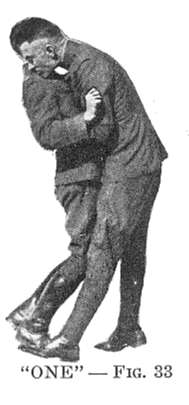
"TWO"
Clench fist with thumb jutting out. Insert end of thumb (not the nail)
beneath Assailant's nose just where the nose joins the face, so that the
thumb presses partly against his upper lip and partly against the nose
bone where it joins the face.
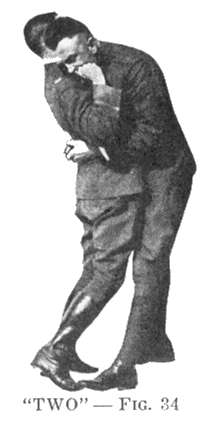
There is a very sensitive spot here, which you can locate by experimenting
on your own nose. [EN1]
If he turns his nose to your right use your left thumb. If he turns
to the left, use your left thumb. If he buries his nose in your chest,
bring up both thumbs and dig for it.
"THREE"
Push Assailant's head back until he releases his waisthold.
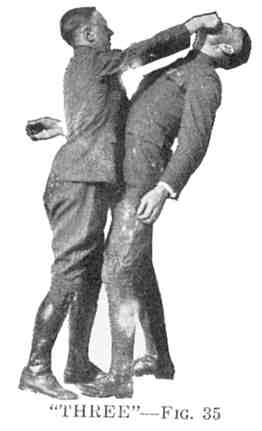
Do not touch his face with your hand. The only point of contact is your
thumb. Otherwise you decrease the pressure your thumb exerts on the vital
spot.
Do this very slowly at first in order not to hurt partner's nose.
His nose is not pushed but the sensitive spot where nose meets face
should be pressed upwards in the direction of his ears.
Pushing at this angle makes it easy to get his head back.
"FOUR"
Bring your knee up into his stomach making the effort from the Stahara.
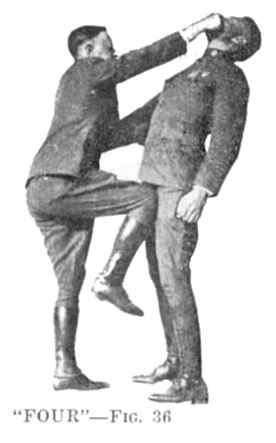
In practice stop three inches from the mark at which you aim.
THE PSYCHOLOGY OF THE NOSE PUSH
When a man has seized a woman with criminal intent and endeavors to
carry her off, an escape is easy if the thumb be pressed not beneath his
nose, but into his eyes. [EN2]
Such a course would be justifiable only where life is in danger. If
you are unarmed you have a right to take such action as is necessary to
save yourself.
Making a mental note of this, however, is not giving yourself adequate
training in self-defense. You might forget to do it. A woman would be apt
to lose her head and scream aimlessly.
Sticking your fingers in a man's eye is too dangerous a trick to try
on one another but the Nose Push may be practiced with safety. You will
thus be made familiar with such an attack, and will think coolly and act
instinctively.
A system that merely tells you to stick your finger in a man's
eye does not give you a proper education in self-defense.
Your reflex action must be trained so that you will act instinctively
in the moment of danger.
WHEN TO USE THE KNEE KICK
If you are attacked by a thug with a knife or pistol or a piece of lead
piping or a sandbag, or if your life is in danger and you are unarmed,
you are justified in defending yourself by attacking your Assailant's
most vital spots -- his crotch or his eyes.
Under no other circumstances would you be justified in resorting to
these foul, unspeakable methods. It is unthinkable that a fair man in a
fair fight or even an unfair fight, would ever stain his honor by such
a dishonorable action.
The same thing applies to women, only in the last extremity would it
be defensible for her to use such tactics.
However, there are unfortunately many instances where the most dastardly
attacks are perpetrated and the victims are defenseless because they do
not know how to use the weapons with which nature has provided them.
In such an instance you would be accessory to your own death if you
hesitated to disable or kill him, by the above methods.
You might have such a margin of superiority in strength and skill that
you could take him prisoner by a jujitsu grip or knock him out by one of
the legitimate blows to his jaw, neck, or solar plexus, and you must use
the more humane method where possible.
But in the last analysis, the eyes and crotch are the vital spots and
an attack on them is the first thing to do when it is a question of life
or death.
It is often asked -- "Instead of that trick you are teaching would it
not be simpler to raise the knee and kick him?" The answer is unhesitatingly,
"YES." If there is to be any kicking, kick first. But in the general run
of things you would not be justified in kicking and must be trained in
more honorable methods, reserving the kick for an emergency.
These other tricks must be practiced faithfully because they give you
presence of mind and an ability to use your body correctly.
ESCAPE FROM CHIN SHOVE
Assailant attacks you with chin shove, his right hand on your chin,
his left hand round your waist.
If you stand with feet on the same line you will be immediately unbalanced
and unable to resist.
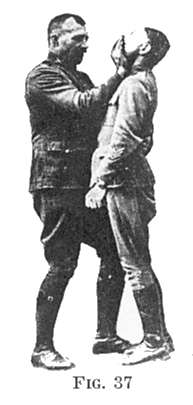
"ONE"
As he takes hold, step back with either foot and take a balanced position.
Bring your left elbow close to your side and palm of left hand onto
Assailant's forearm.

"TWO"
Assailant pushes your had back and pulls your waist in.
Throw your head back quicker than it is pushed, knocking up his right
arm with your left arm.
Keep your eyes on Assailant.

"THREE"
Instantly regain your balance and shove Assailant's chin back with your
right hand.
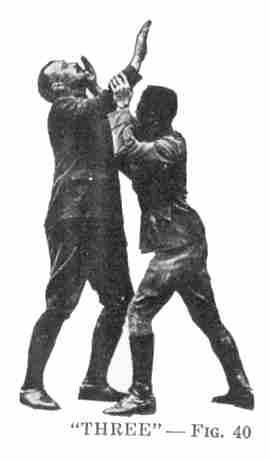
"FOUR"
Make Assailant stagger slowly backwards. Bring up your knee with full
force, stopping three inches from the target.
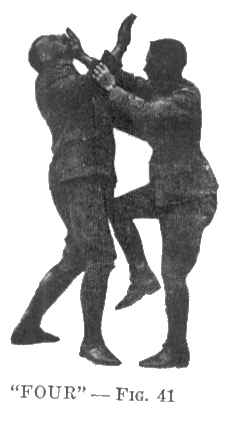
This practice will make you dexterous in using both hands and feet in
a fight and trains you to make your every movement for the purpose of unbalancing
opponent.
Keep your balance and make the effort from the Stahara.
ESCAPE FROM CHIN SHOVE
Understand in a real fight you would not shove but would hit your opponent
so hard with the heel of your hand below his chin that you would knock
him out.
Practice of this trick will give you the power to deliver such a blow
and also the presence of mind to use it.
Also without hitting it is possible to shove so hard that opponent is
knocked out by the fall.
In practice go no further than unbalancing opponent with a slow shove.
The practice of this trick has greater advantages than merely teaching
you a defense against this attack. It teaches you how to use your body
quickly in a way that will be valuable in all attacks.
You do not pull his hand away from your chin but evade it by giving
way. The effort is made with a swaying motion of the Stahara which keeps
your balance.
Take the position of each of the five photos illustrating this trick,
and compare your position with them.
Practice it slowly at first. Afterwards you will do it so quickly that
an onlooker could not explain what you had done.
In a real fight you would knock Assailant's hand away, and counter,
before he got you in the grip illustrated by fig. 38.
BALANCE AND MOMENTUM
Jujitsu tricks are done with great rapidity on an opponent who is usually
moving just as quickly. You utilize the momentum of the opponent to unbalance
and defeat him instead of relying on your own strength and weight.
If you try to master the two complicated problems of your opponent's
BALANCE and MOMENTUM and at the same time make your legs and arms perform
a complicated, unfamiliar feat, you are up against an intricate task in
which progress is slow. This is why it takes so many years in Japan to
learn jujitsu.
The system by which this book teaches is radically different. It eliminates
the factor of MOMENTUM by causing the teacher to stand still until the
student commences to use his body properly and until he understands how
to unbalance his opponent.
When this stage is reached, the student's subconscious attends to the
proper working of the arms and legs and to unbalancing opponent, leaving
the active mind free to watch opponent's momentum.
The teacher now adds a little movement to the lesson and finally attacks
the student swiftly.
As each student alternately takes the role of Instructor (or Assailant),
he will stand stationary and allow his opponent (or pupil) to master the
movements of arms and legs and to discover how to unbalance his Assailant.
He may then combine movement with his instructions and his pupil will
readily learn to deal with the factor of momentum.
THE WAISTHOLD SERIES
When engaged in training thousands of men who knew nothing of wrestling
and boxing and who would shortly be engaged in savage trench warfare, the
most important thing was to teach them to deal their opponent a kick or
blow in a vital spot.
Merely telling them of these blows was not sufficient. The untrained
man would think of these tricks after the battle and would sadly exclaim:
"Oh, if I had only done so-and-so."
They were first taught to kick with the whole weight of the body. Merely
kicking with the muscles of the leg and thigh does not deliver a blow one-third
as powerful as if you "put your Stahara" into it.
The waisthold series, consisting of:
waisthold, chin shove, nose push, and escape from chin shove,
gave them more actual practice in five minutes than half-an-hour of desultory
wrestling would.
A class of a thousand men could be trained in these methods with the
same precision, snap, and disciplinary effect as army disciplinary calisthenics,
or setting-up exercises.
A scientific analysis of each trick enabled the movements to be directed
from a platform, step by step, and the soldier learned the movements as
quickly and correctly as if he were getting a personal lesson from the
instructor.
The same scientific analysis has been followed in these pages. The photos
take the place of the platform demonstration, and the printed words take
the place of commands.
Take the position of each illustration and slowly practice the movement
described and you will learn how to apply your strength.
LESSON 8
This lesson teaches you --
Methods of practice for husband and wife.
The psychology of training.
Three different methods of Throat Attack.
First defense to Throat Attack.
Second defense to Throat Attack.
Third defense to Throat Attack.
Edge of hand blow.
| |
Name of Partner |
Date Practice Commenced |
1st Defense |
2nd Defense |
3 rd Defense |
| 1. |
|
|
|
|
|
| 2. |
|
|
|
|
|
| 3. |
|
|
|
|
|
| 4. |
|
|
|
|
|
| 5. |
|
|
|
|
|
| 6. |
|
|
|
|
|
| 7. |
|
|
|
|
|
| 8. |
|
|
|
|
|
| 9. |
|
|
|
|
|
| 10. |
|
|
|
|
|
Place a check mark against each trick each day you practice it.
A USELESS METHOD OF DEFENSE
It is useless when thus attacked to seize Assailant's wrists and try
to pull them off.
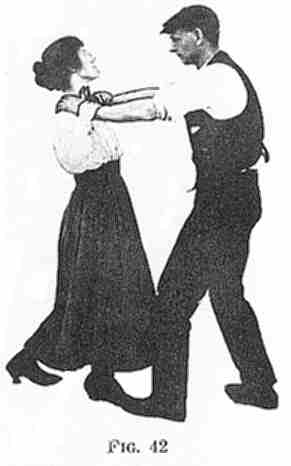
Yet that is what most people would do under the paralyzing effects of
fear.
It is almost as useless to try and seize a finger and pry his grip open,
or even break the finger. If he is strong he would have you nearly choked
before you could accomplish this.
Even if you are stronger than Assailant is, strength is not nearly so
speedy a way of conquering him as the methods given here, particularly
the Third Method.
METHODS OF PRACTICE FOR HUSBAND AND WIFE
If a husband wishes to teach his wife the defense tricks he will assume
the role of Assailant, as directed, and attack her with the attempted strangle,
the waisthold, etc.
In attacking her throat, he will place his hands on her shoulders and
his thumbs on her windpipe, gently, without pressure, and will remain in
that position while she slowly executes the defense, practicing this again
and again until she acquires speed, and until she can act without hesitation.
He may then hold her neck with gradually increasing pressure in his
fingers, carefully avoiding pressure with his thumbs.
Soon she will learn to anticipate the attack and will act so quickly
that the defense is made before his fingers can reach her throat.
THE PSYCHOLOGY OF TRAINING
In this way her reflex action is being trained and an attempted move
on the part of a ruffian on the street on a dark night would stimulate
her reflex action to perform the necessary defense without having to hesitate
and think of what to do.
It will train her to act in the face of danger and free her from the
paralyzing effects of fear.
The partner with whom you practice knows what your defense will be but
must not take advantage of this knowledge to escape or parry the defense.
He must attack again and again without variation.
Remember that the ruffian who attacks you on the street does not know
what your defense will be and probably expects no opposition at all.
Your properly executed defense will incapacitate him before he has time
to change his method of attack.
DIFFERENT METHODS OF THROAT ATTACK
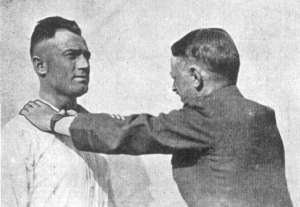
An Assailant might press his thumbs directly into your windpipe.
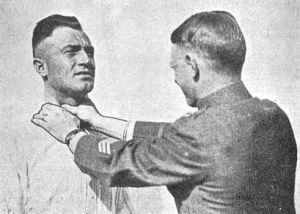
Or he might cross his thumbs over your windpipe. A strong man could
strangle you this way with one hand.
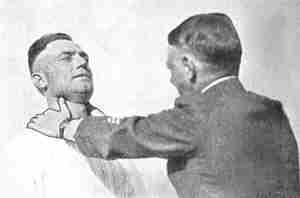
Some men would place the ends of their thumbs on the glands of your
neck. This is a very painful grip.
The following lesson provides an adequate defense against any of these
methods of attack.
In practice the Assailant may use any of these methods of attack but
should exert no pressure with his thumbs.
At first he will merely place his hands on his partner's throat until
the partner is familiar with the defense. Later on he will shove you gently.
You will retreat more quickly than he shoves, unbalancing him as you retreat,
and perform the counter.
Increase the speed of the attack gradually, but never become rough enough
to injure one another.
In an actual combat the Assailant might not only try to choke you but
to knock you over backward as well. The quickest way to master the defense
to the roughest kind of attack is to eliminate the factor of momentum,
and practice the trick stationary, until you have mastered all the details
except momentum.
If you make your partner shove you while attacking, you will quickly
catch on.
FIRST DEFENSE TO THROAT ATTACK
Assailant seizes your throat.
Bring your palms together.
(In practice, Assailant must hold tightly with his fingers, but will
not press your throat with his thumbs.)
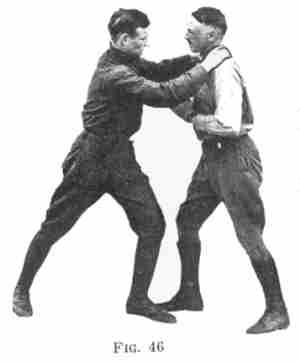
Bring your hands like a wedge smartly up between his arms, thus breaking
his hold.
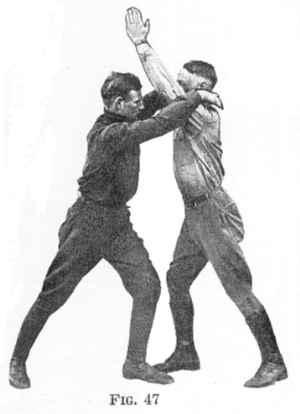
Place your hands behind his head or on his neck.

Pull his head smartly down, simultaneously bringing up your knee onto
his nose with sufficient force to knock him out.
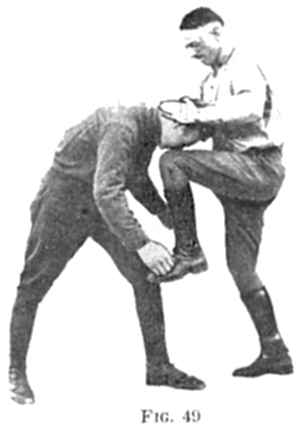
In practice, stop the blow three or four inches from his nose.
Make the effort from the Stahara to ensure efficient coordination between
arms and legs, and keep your balance.
SECOND DEFENSE TO THROAT ATTACK
Assailant seizes your throat.
Clasp your hands together as in fig. 50.
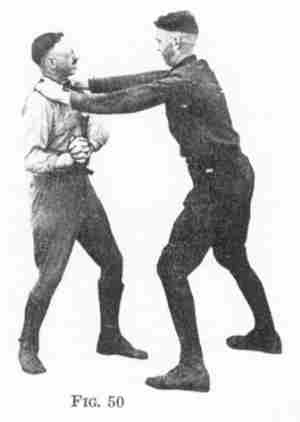
Swing forearms upward against the side of Assailant's arms, thus breaking
his hold.
Then strike him on the side below his ribs with your double clenched
fists.
THREE METHODS OF DEFENSE FOR THROAT ATTACK
There are three methods of defense against throat attack taught in this
lesson. The third one is by far the best. After this course is completed
you will discard the first and second -- they are merely preliminary training.
A person who uses arm strength alone would not find the third method
much better than the others, and would not be able to say why it was better,
but you, who are working on the Stahara principle, will soon notice that
the third method enables you to discount Assailant's strength to a greater
extent, and to deal a more deadly return blow.
If you were taught only one method, you would know so little about the
principles of the art that anyone who could do another trick efficiently
-- perhaps by sheer superiority of physical strength -- would be able to
prevail upon you to discard your former method.
The first and second methods have their place in this scheme of training
as they give you experience in using your body in different positions,
and give you greater resources of tactics to draw on -- for instance, when
the chance presents itself, you would be able to use the knee smash on
nose.
When this course is completed, however, your reflex action will make
you automatically use the third method and scrap the others.
THE WRIST TWIST AND OTHER COMPLICATED DEFENSES
The wrist twists in Book 6 are also excellent defenses but if you are
outmatched by Assailant's strength, use the third method given here, it
is your best bet.
THE KNEE KICK
Bear in mind during your practice that in certain circumstances you
would be justified in using the knee kick, and when matters come to that
pass, kick swiftly, and then follow up with the third method, or take him
prisoner with the wrist twist.
In other words, while you faithfully practice these other methods, look
upon them as a means to an end, as a training in the effective use to an
end, as a training in the effective use of the body, but where it is a
case of life or death, use the knee kick, before your Assailant has time
to get in his dirty work.
THIRD DEFENSE AGAINST THROAT ATTACK
Assailant takes the throat hold.

Swing your right elbow up over Assailant's left arm, knocking his hands
away from your throat and throwing him off balance.
Make the swing, not with the arm, but with the whole body (the Stahara).
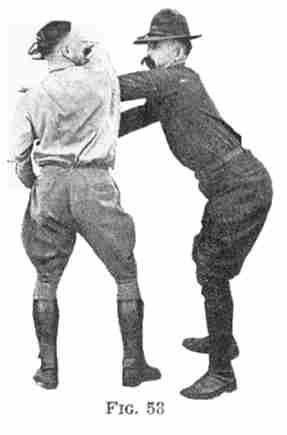
Swing your elbow back full into Assailant's neck or jaw. They are both
equally vital points and a fair blow will lay him out.
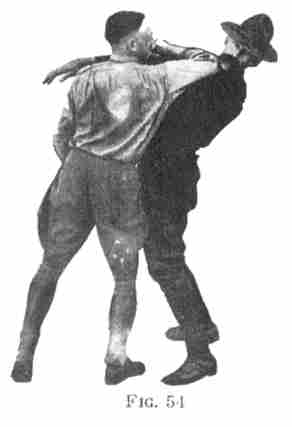
In practice stop the blow three or four inches from your partner's
neck.
As you swing in fig. 53, step forward and inward with your right foot
and step backward and to the right with your left foot. Compare your position
carefully with fig. 53.
Do not knock his arm away with your arm, but bring your armpit in contact
with his arm. The swing of the body knocks his arm away and also twists
your neck out of his grasp.
Practice this until you get the knack of playing the strength of your
body against the strength of his arm. Until this knack is acquired, speed
should not be attempted.
After mastering this trick -- the third defense, discard the other two
-- the first and second defenses.
THE BLOW WITH THE EDGE OF THE HAND
When standing with your right side towards your opponent, strike him
with the little finger edge of your right hand on the right side of the
neck.

In practice deliver the blow with full force stopping short three or
four inches from your training partner's neck.
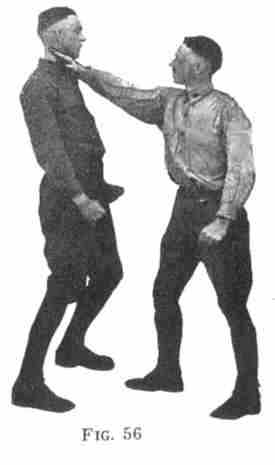
When standing with your left side towards your opponent, strike him
with the little finger side of your left hand on the left side of his neck.
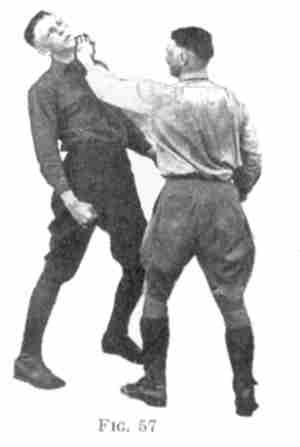
On the preceding pages you have been taught how to defend yourself against
an attack on the throat.
If you wish to attack anyone by the throat you will find the blow with
the edge of the hand a much more speedy and efficacious method than the
attempted choke with the thumbs.
This is always a backhanded blow, and will drop a man like a log.
THE BLOW WITH THE EDGE OF THE HAND
People sometimes ask whether the blow with the edge of the hand on the
throat is more effective than a blow with the fist.
It is, one reason being that you cannot reach the throat with the fist
so effectively as you can with the edge of the hand.
But that is not the point. The blow with the edge of the hand is given
when you are in a position to deliver it and when you are not in a position
to strike with the fist.
Conversely, if you are in a position to deliver an effective blow with
the fist, as to the jaw, you would use the fist for you are then not in
a position to deliver a blow with the edge of the hand.
In the combination trick of wrist escape and neck blow, Book 3, you
can twist your wrist free and deliver the cut with the edge of the hand
much more quickly than you could hit with the fist.
Furthermore the edge of the hand blow is not expected and consequently
not guarded against, whereas the blow with the fist is more likely to be
expected and so guarded against.
It is unnecessary to harden the edge of your hand by constant practice
to acquire a hard hitting edge. When you deliver the blow, the hand is
held straight and rigid and the point impact is the third joint of the
little finger.
A woman of ordinary strength can learn to deliver a blow that will knock
out the strongest man whereas a blow from her fist on his chin would only
annoy him and cut her knuckles.
You may experiment once or twice on friend husband. Tell him to tense
his neck, just give him a little tap, and see how he likes it.
EDITOR'S NOTES
EN1. In more precise terms, this point is located
immediately below the septum, which is the fleshy piece separating the
nostrils. The targets include a bone joint known as the intermaxillary
suture and a major facial nerve known as the nasopalatine nerve.
The acupressure point is Governing Vessel 26.
EN2. Thumbing is very common in professional boxing,
and is a leading cause of retinal injuries. During self-defense training,
in his book On Killing: The Psychological Cost of Learning to Kill in
War and Society (Boston: Little, Brown, 1995), Lt. Col. Dave Grossman
suggests taping an orange over the Assailant's eye and then having the
defender practice pushing hard enough to make the orange squirt.


































